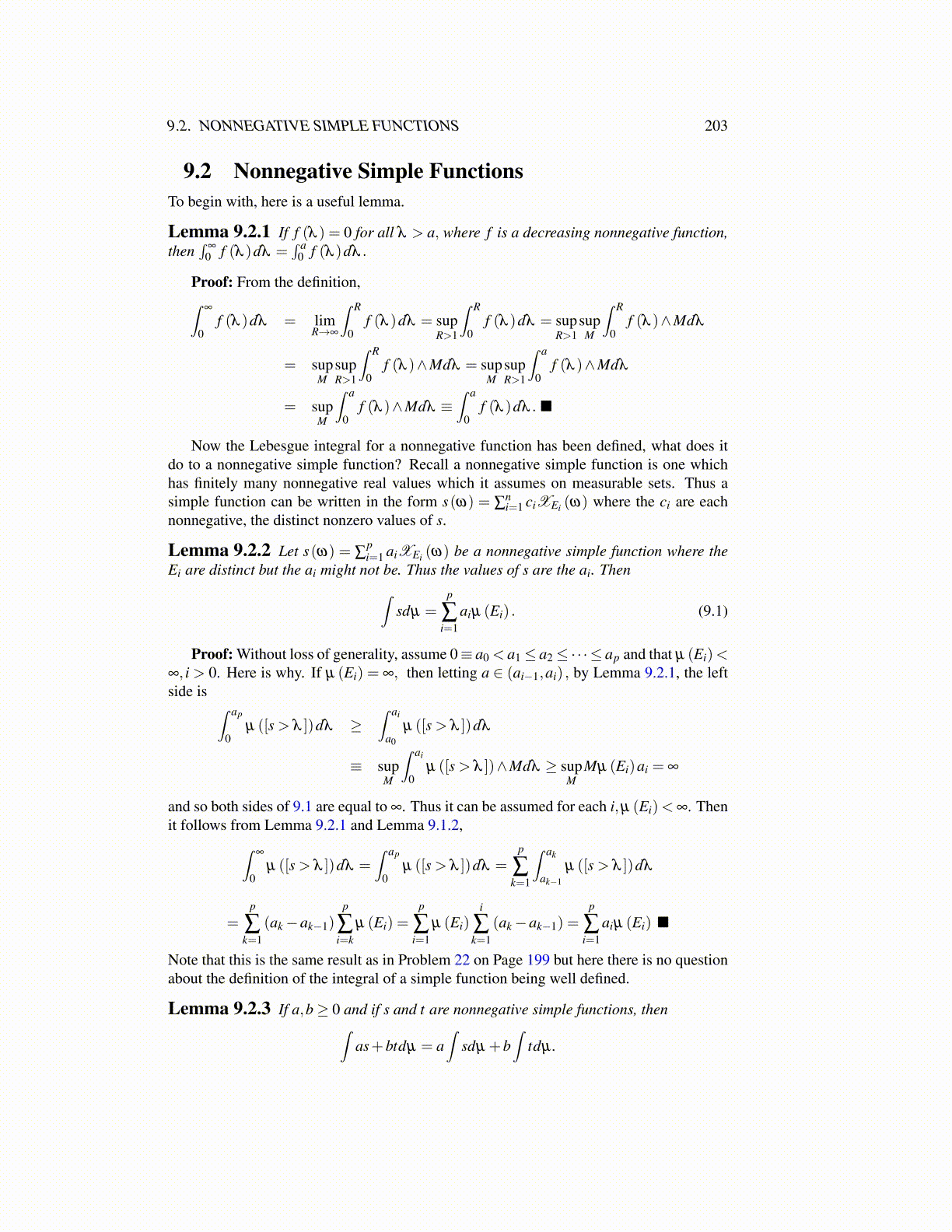
9.2. NONNEGATIVE SIMPLE FUNCTIONS 203
9.2 Nonnegative Simple FunctionsTo begin with, here is a useful lemma.
Lemma 9.2.1 If f (λ ) = 0 for all λ > a, where f is a decreasing nonnegative function,then
∫∞
0 f (λ )dλ =∫ a
0 f (λ )dλ .
Proof: From the definition,∫∞
0f (λ )dλ = lim
R→∞
∫ R
0f (λ )dλ = sup
R>1
∫ R
0f (λ )dλ = sup
R>1sup
M
∫ R
0f (λ )∧Mdλ
= supM
supR>1
∫ R
0f (λ )∧Mdλ = sup
MsupR>1
∫ a
0f (λ )∧Mdλ
= supM
∫ a
0f (λ )∧Mdλ ≡
∫ a
0f (λ )dλ . ■
Now the Lebesgue integral for a nonnegative function has been defined, what does itdo to a nonnegative simple function? Recall a nonnegative simple function is one whichhas finitely many nonnegative real values which it assumes on measurable sets. Thus asimple function can be written in the form s(ω) = ∑
ni=1 ciXEi (ω) where the ci are each
nonnegative, the distinct nonzero values of s.
Lemma 9.2.2 Let s(ω) = ∑pi=1 aiXEi (ω) be a nonnegative simple function where the
Ei are distinct but the ai might not be. Thus the values of s are the ai. Then∫sdµ =
p
∑i=1
aiµ (Ei) . (9.1)
Proof: Without loss of generality, assume 0≡ a0 < a1≤ a2≤ ·· · ≤ ap and that µ (Ei)<∞, i > 0. Here is why. If µ (Ei) = ∞, then letting a ∈ (ai−1,ai) , by Lemma 9.2.1, the leftside is ∫ ap
0µ ([s > λ ])dλ ≥
∫ ai
a0
µ ([s > λ ])dλ
≡ supM
∫ ai
0µ ([s > λ ])∧Mdλ ≥ sup
MMµ (Ei)ai = ∞
and so both sides of 9.1 are equal to ∞. Thus it can be assumed for each i,µ (Ei)< ∞. Thenit follows from Lemma 9.2.1 and Lemma 9.1.2,∫
∞
0µ ([s > λ ])dλ =
∫ ap
0µ ([s > λ ])dλ =
p
∑k=1
∫ ak
ak−1
µ ([s > λ ])dλ
=p
∑k=1
(ak−ak−1)p
∑i=k
µ (Ei) =p
∑i=1
µ (Ei)i
∑k=1
(ak−ak−1) =p
∑i=1
aiµ (Ei) ■
Note that this is the same result as in Problem 22 on Page 199 but here there is no questionabout the definition of the integral of a simple function being well defined.
Lemma 9.2.3 If a,b≥ 0 and if s and t are nonnegative simple functions, then∫as+btdµ = a
∫sdµ +b
∫tdµ .